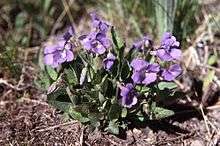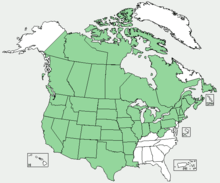Viola nephrophylla
Viola nephrophylla (northern bog violet, Leconte violet, or kidney leaved violet) syn. Viola nephrophylla Greene f. albinea (Farw.), Viola pratincola Greene, Viola retusa Greene ) is an annual or perennial forb in the Violet family (Violaceae) native to North America.[1]
| Viola nephrophylla | |
|---|---|
 | |
| Scientific classification | |
| Kingdom: | Plantae |
| Clade: | Tracheophytes |
| Clade: | Angiosperms |
| Clade: | Eudicots |
| Clade: | Rosids |
| Order: | Malpighiales |
| Family: | Violaceae |
| Genus: | Viola |
| Species: | V. nephrophylla |
| Binomial name | |
| Viola nephrophylla | |
 | |
| Distribution of Viola nephrophylla | |
| Synonyms | |
| |
Viola nephrophylla was named by Edward Lee Greene in 1896 from specimens he collected near Montrose, Colorado. The species name, nephrophylla, is from the Greek for "kidney shaped leaves".[2]
Conservation status within the United States
It is listed endangered in Massachusetts, New York, and Ohio, as threatened in New Hampshire,[3] and as a special concern in Connecticut.[4]
Native American ethnobotany
The Ramah Navajo use the plant as a ceremonial emetic.[5]
gollark: Correction, 9 years, I keep getting that mixed up.
gollark: Actually, we use a ~11-year-old commodity tower server retrofitted with a GTX 1050 I had.
gollark: This is a good use of money, I checked.
gollark: While you're here, you should donate £1000 to osmarks.net to buy a better GPU with, for purposes.
gollark: It does exist.
References
- "Viola nephrophylla". Robert W. Freckmann Herbarium University of Wisconsin - Stevens Point. Retrieved 2010-03-10.
- Schneider, Al. "Viola". Southwest Colorado Wildflowers. Gothic, Colorado: Rocky Mountain Biological Laboratory. Retrieved 2010-03-10.
- "Plants Profile for Viola nephrophylla (northern bog violet)". plants.usda.gov. Retrieved 15 January 2018.
- "Connecticut's Endangered, Threatened and Special Concern Species 2015" (PDF). State of Connecticut Department of Energy and Environmental Protection Bureau of Natural Resources. Retrieved 15 January 2018. (Note: This list is newer than the one used by plants.usda.gov and is more up-to-date.)
- Vestal, Paul A. (1952). "The Ethnobotany of the Ramah Navaho". Papers of the Peabody Museum of American Archaeology and Ethnology. 40 (4): 36.
This article is issued from Wikipedia. The text is licensed under Creative Commons - Attribution - Sharealike. Additional terms may apply for the media files.